#nancy kilgas
Explore tagged Tumblr posts
Text
𝒯𝒽𝑒 1940'𝓈-1950'𝓈 𝓌𝑒𝓇𝑒 𝓉𝒽𝑒 𝒷𝑒𝓈𝓉 𝓉𝒾𝓂𝑒 𝒻𝑜𝓇 𝓂𝓊𝓈𝒾𝒸𝒶𝓁𝓈, 𝒶𝓃𝒹 ℐ 𝑜𝓃𝓁𝓎 𝒽𝒶𝓋𝑒 3 𝓂𝓊𝓈𝒾𝒸𝒶𝓁 𝒻𝒾𝓁𝓂𝓈 𝓉𝒽𝒶𝓉 𝓇𝑒𝒶𝓁𝓁𝓎 𝓈𝓉𝓇𝒾𝓀𝑒 𝓂𝓎 𝒻𝒶𝓃𝒸𝓎. 𝒯𝒽𝑒 𝒻𝒾𝓇𝓈𝓉 𝒻𝑜𝓇 𝓂𝑒 𝑜𝓃 𝓉𝒽𝑒 𝓁𝒾𝓈𝓉 𝒾𝓈 𝓢𝓮𝓿𝓮𝓷 𝓑𝓻𝓲𝓭𝓮𝓼 𝓯𝓸𝓻 𝓢𝓮𝓿𝓮𝓷 𝓑𝓻𝓸𝓽𝓱𝓮𝓻𝓼, 𝓉𝒽𝒾𝓈 𝒾𝓈 𝓉𝒽𝑒 𝒻𝒾𝓁𝓂 𝓉𝒽𝒶𝓉 𝓂𝒶𝒹𝑒 𝓂𝑒 𝑒𝓃𝓇𝑜𝓁𝓁 𝒾𝓃𝓉𝑜 𝒷𝒶𝓁𝓁𝑒𝓉. 𝒯𝒽𝑒 𝓈𝑜𝓃𝑔𝓈 𝓌𝑒𝓇𝑒 𝒷𝑒𝒶𝓊𝓉𝒾𝒻𝓊𝓁 𝒶𝓃𝒹 𝓉𝒽𝑒 𝒹𝒶𝓃𝒸𝑒𝓇𝓈 𝓌𝑒𝓇𝑒 𝑜𝒻 𝓅𝓊𝓇𝑒 𝓉𝒶𝓁𝑒𝓃𝓉 𝒶𝓃𝒹 𝑔𝓇𝒶𝒸𝑒𝒻𝓊𝓁𝓃𝑒𝓈𝓈, 𝒷𝓊𝓉 ℐ 𝒶𝒷𝓈𝑜𝓁𝓊𝓉𝑒𝓁𝓎 𝓁𝑜𝓋𝑒𝒹 𝓉𝒽𝑒 𝓅𝓁𝑜𝓉 𝑜𝒻 𝓉𝒽𝑒 𝓈𝓉𝑜𝓇𝓎. 𝒮𝑒𝓋𝑒𝓃 𝓂𝑜𝓊𝓃𝓉𝒶𝒾𝓃𝑜𝓊𝓈 𝒷𝓇𝑜𝓉𝒽𝑒𝓇𝓈 𝒷𝑜𝓇𝓃 𝑜𝒷𝓉𝒶𝒾𝓃𝒾𝓃𝑔 𝒷𝒾𝒷𝓁𝒾𝒸𝒶𝓁 𝓃𝒶𝓂𝑒𝓈 𝒻𝑒𝑒𝓁 𝓉𝒽𝑒 𝓃𝑒𝑒𝒹 𝒻𝑜𝓇 𝒸𝑜𝓂𝓅𝒶𝓃𝒾𝑜𝓃𝓈𝒽𝒾𝓅 𝒶𝓁𝓈𝑜 𝑔𝑜𝒾𝓃𝑔 𝓉𝑜 𝒶 𝒷𝒶𝓇𝓃 𝓇𝒶𝒾𝓈𝒾𝓃𝑔 𝒸𝑒𝓇𝑒𝓂𝑜𝓃𝓎 𝒶𝓃𝒹 𝑜𝒻 𝒸𝑜𝓊𝓇𝓈𝑒 𝒶𝒻𝓉𝑒𝓇 𝓉𝒽𝑒𝒾𝓇 𝑒𝓁𝒹𝑒𝓈𝓉 𝒷𝓇𝑜𝓉𝒽𝑒𝓇 𝑔𝑒𝓉𝓈 𝓂𝒶𝓇𝓇𝒾𝑒𝒹 𝒶𝓁𝓈𝑜. 𝒯𝒽𝑒𝓎'𝓇𝑒 𝒹𝑒𝓁𝒾𝑔𝒽𝓉𝑒𝒹 𝒷𝓎 𝓉𝒽𝑒 𝒸𝒽𝑒𝓂𝒾𝓈𝓉𝓇𝓎 𝓉𝒽𝑒𝓎 𝒻𝑒𝓁𝓉 𝒹𝓊𝓇𝒾𝓃𝑔 𝓉𝒽𝑒 𝒸𝑒𝓇𝑒𝓂𝑜𝓃𝓎 𝓌𝒾𝓉𝒽 𝓉𝒽𝑒 𝓎𝑜𝓊𝓃𝑔 𝓉𝑜𝓌𝓃𝓈𝓌𝑜𝓂𝑒𝓃, 𝒷𝓊𝓉 𝓉𝒽𝑒 𝒷𝓇𝑜𝓉𝒽𝑒𝓇𝓈 𝑔𝑜 𝒶 𝓁𝒾𝓉𝓉𝓁𝑒 𝓉𝑜𝑜 𝒻𝒶𝓇 𝒾𝓃 𝒽𝑜𝓌 𝓉𝑜 𝓌𝒾𝓃 𝓉𝒽𝑒 𝓁𝒶𝒹𝒾𝑒𝓈 𝒽𝑒𝒶𝓇𝓉𝓈. 𝒯𝒽𝒾𝓈 𝓂𝑜𝓋𝒾𝑒 𝓌𝒶𝓈 𝓌𝑜𝓃𝒹𝑒𝓇𝒻𝓊𝓁 𝓉𝑜 𝓌𝒶𝓉𝒸𝒽 𝓌𝒽𝑒𝓃 ℐ 𝓌𝒶𝓈 𝓁𝒾𝓉𝓉𝓁𝑒, 𝓅𝓁𝓊𝓈 ℐ 𝒶𝓁𝓇𝑒𝒶𝒹𝓎 𝒽𝒶𝒹 𝒶 𝓂𝒶𝒹 𝒸𝓇𝓊𝓈𝒽 𝑜𝓃 𝑜𝓃𝑒 𝑜𝒻 𝓉𝒽𝑒 𝒷𝓇𝑜𝓉𝒽𝑒𝓇𝓈 𝒾𝓃 𝓉𝒽𝑒 𝒻𝒾𝓁𝓂, 𝒶𝓃𝒹 𝓉𝒽𝒶𝓉 𝒷𝓇𝑜𝓉𝒽𝑒𝓇 𝓌𝒶𝓈 𝓉𝒽𝑒 𝓎𝑜𝓊𝓃𝑔𝑒𝓈𝓉 𝑜𝓃𝑒 𝓀𝓃𝑜𝓌𝓃 𝒶𝓈 𝗚𝗶𝗱𝗲𝗼𝗻 𝒶𝓀𝒶 𝐑𝐮𝐬𝐬 𝐓𝐚𝐦𝐛𝐥𝐲𝐧. ℐ 𝓊𝓈𝑒𝒹 𝓉𝑜 𝓌𝒶𝓉𝒸𝒽 𝐌𝐫. 𝐓𝐚𝐦𝐛𝐥𝐲𝐧 𝒾𝓃 𝒻𝒾𝓁𝓂𝓈 𝓌𝒽𝑒𝓃 𝒽𝑒 𝓌𝒶𝓈 𝓂𝓊𝒸𝒽 𝓎𝑜𝓊𝓃𝑔𝑒𝓇 𝓉𝑜𝑜 𝒷𝓊𝓉 𝒽𝒾𝓈 𝒶𝓉𝒽𝓁𝑒𝓉𝒾𝒸𝒾𝓈𝓂 𝓅𝓁𝓊𝓈 𝒽𝒶𝓃𝒹𝓈𝑜𝓂𝑒𝓃𝑒𝓈𝓈 𝒷𝓇𝑜𝓊𝑔𝒽𝓉 𝓂𝑒 𝒾𝓃 𝓂𝑜𝓇𝑒. 𝒯𝒽𝑒𝓇𝑒 𝓌𝑒𝓇𝑒 𝒶 𝓁𝑜𝓉 𝑜𝒻 𝓅𝓇𝑜𝒻𝑒𝓈𝓈𝒾𝑜𝓃𝒶𝓁𝓎 𝓉𝓇𝒶𝒾𝓃𝑒𝒹 𝓈𝒾𝓃𝑔𝑒𝓇𝓈 𝒶𝓃𝒹 𝒹𝒶𝓃𝒸𝑒𝓇𝓈 𝒾𝓃 𝓉𝒽𝒾𝓈 𝒻𝒾𝓁𝓂 𝒶𝓃𝒹 𝒾𝓉 𝓂𝒶𝓀𝑒𝓈 𝓂𝑒 𝒽𝒶𝓅𝓅𝓎 𝑒𝓋𝑒𝓇𝓎 𝓉𝒾𝓂𝑒 ℐ 𝓋𝒾𝑒𝓌 𝒾𝓉. 𝓢𝓮𝓿𝓮𝓷 𝓑𝓻𝓲𝓭𝓮𝓼 𝓯𝓸𝓻 𝓢𝓮𝓿𝓮𝓷 𝓑𝓻𝓸𝓽𝓱𝓮𝓻𝓼 𝒾𝓈 𝒶 𝓂𝓊𝓈𝓉 𝓌𝒶𝓉𝒸𝒽 𝓂𝓊𝓈𝒾𝒸𝒶𝓁 ℐ 𝓀𝓃𝑜𝓌 𝓎𝑜𝓊'𝓁𝓁 𝑒𝓃𝒿𝑜𝓎. ❤︎
#Seven Brides for Seven Brothers (1954)#Musical/Romance#Howard Keel ✝︎#Jane Powell ✝︎#Jeff Richards ✝︎#Matt Mattox ✝︎#Nancy Kilgas#Tommy Rall ✝︎#Betty Carr ✝︎#Russ Tamblyn#Julie Newmar#Norma Doggett ✝︎#Ruta Lee#Jacques d'Amboise ✝︎#Virginia Gibson ✝︎#Ian Wolfe ✝︎
6 notes
·
View notes
Photo
Howard Keel as Adam Pontipee poses with the six brides for his six brothers [top row, left to right:] Nancy Kilgas as Alice Elcott, Betty Carr as Sarah Kine, and Ruta Lee (then known as Ruta Kilmonis) as Ruth Jepson; and [bottom row, left to right:] Norma Doggett as Martha, Virginia Gibson as Liza, and Julie Newmar (then known as Julie Newmeyer) as Dorcas Gaylen.

Stanley Donen’s SEVEN BRIDES FOR SEVEN BROTHERS (‘54)
#historical hollywood#classic hollywood#seven brides for seven brothers#1954#1950s#promotional photos#movie musicals#wild wild westerns#period films#in the good old former time#howard keel#nancy kilgas#betty carr#ruta lee#ruta kilmonis#norma doggett#virginia gibson#julie newmar#strike a pose#glorious technicolor#gorgeous in green#winsome in white#scandalous in scanties
82 notes
·
View notes
Photo


Costume designer Walter Plunkett created this pretty pink 💗 gown for 1949’s 𝑳𝒊𝒕𝒕𝒍𝒆 𝑾𝒐𝒎𝒆𝒏, 👩👩👧👦 where June Allyson wore it as Jo March. Interestingly, this was the second production of 𝑳𝒊𝒕𝒕𝒍𝒆 𝑾𝒐𝒎𝒆𝒏 that Plunkett worked on, having previously created the costumes for the 1933 adaptation. The pink dress appeared again, worn by Nancy Kilgas in 1954 as Alice in 𝘚𝘦𝘷𝘦𝘯 𝘉𝘳𝘪𝘥𝘦𝘴 𝘧𝘰𝘳 𝘚𝘦𝘷𝘦𝘯 𝘉𝘳𝘰𝘵𝘩𝘦𝘳𝘴! 👰 🔗 Find more reused costumes on our website!
#LittleWomen#SevenBridesForSevenBrothers#JuneAllyson#JoMarch#NancyKilgas#RecycledMovieCostumes#GoGreen#Costumes#CostumeDesign#CostumeIdeas#CostumeHistory
123 notes
·
View notes
Text

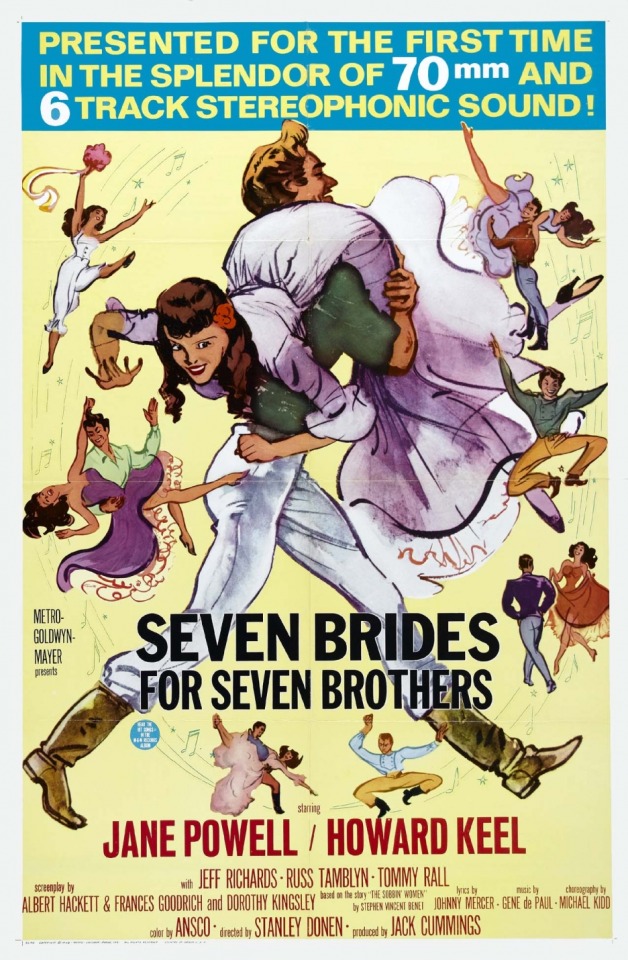

Seven Brides for Seven Brothers (1954)
Directed by: Stanley Donen
Starring: Jane Powell, Howard Keel, Jeff Richards, Julie Newmar, Matt Mattox, Ruta Lee, Marc Platt, Norma Doggett, Jacques d'Amboise, Virginia Gibson, Tommy Rall, Betty Carr, Russ Tamblyn, Nancy Kilgas
Genre: musical, comedy
Six brothers go to town to find wives after their eldest brother gets married.
Warning- so much misogyny!
I watched this movie July '22 and my head was spinning. I can't describe what I was feeling - I was laughing so hard at what I was seeing though certainly not for the intended reasons. I can't say I was totally surprised, because of where the story started and seemed to be leading. Still, I hoped by the time the kidnapping happened things would turn around but I was still baffled. I was yelling at my screen, "Oh please, don't - you aren't seriously going to-! Oh my god, you are! no, NO, NOOOoooO!" I remember feeling like, "damn, I really wish someone was watching this with me", and they could feel as ridiculous as I was feeling. I was gonna put this movie out of my memory because even sharing about it to friends the vibe I generally got back was, "...and you watch this shit?"
DomoDraperr@tiktok watches Seven Brides for Seven Brothers pt. 3
Saw the reaction above (love his 'Watching [_] being uncomfortable but not knowing why' series) and I was crying laughing. So yes, memories came flooding back. And here we are.
Yep, a bunch of brothers kidnap several women. Milly condemns it, and the movie itself sort of says it was a bad thing but only so far as, "boys will be boys" you know what I mean? And all the girls forgive and marry them by the end. This wasn't a few awkward comments; they kidnapped several women and even clobbered one of their suitors. Even though the lead male character, Adam (played by Howard Keel), finally learns what he did was wrong, it was in that typical "if it were my daughter-~" reasoning. Not so much as you shouldn't be taking away the agency of another human being. ... progress, I guess? ...
This movie was a surprise success at the time - as MGM was putting their money on Brigadoon. Critic reviews were positive, it was the 5th most popular film at British box office in 1955, AFI in 2001 ranked it #21 on a list for best musicals, and so on. Yes, quick wiki summary for you and the point is: a movie about a bunch of brothers kidnapping women wasn't controversial. My point is audiences were walking out on Sylvia Scarlett (1935) for a bit of "crossdressing" and more recently Rope (1948) was banned in some cities for being too gay (without ever directly referencing to homosexuality). I think that pretty much sums up US' priorities right now too.
This movie was based on a short story by Stephen Vincent Benet, "The Sobbin' Women", which itself was based on "The Rape of the Sabine Women" myth.
Anyhow, I'm not saying you can't enjoy it or you should feel bad if you do (let's just not try to pretend it isn't what it is). The music about the sobbing women is pretty damn catchy, if I'm being begrudgingly honest. The dancing is fun - even one rare negative contemporary review would admit. And another in '85 describes it as "profoundly sexist and eminently hummable".
I was definitely entertained - eyes wide open the whole way through. Whether it's for the right reasons or not, whether the 'right' reasons matter... up to you if you wanna see for yourself.
McSweeney's Seven Brides for Seven Brothers Explainer by Devorah Blachor (2020)
6 notes
·
View notes
Text
EARTH VS. THE SPIDER (1958) – Episode 193 – Decades of Horror: The Classic Era
“Bring your bug juice and let’s go!” Wait. Are spiders bugs? Shouldn’t they be using spider juice? Join this episode’s Grue-Crew – Daphne Monary-Ernsdorff, Chad Hunt, Doc Rotten, and Jeff Mohr – as they figure out which juice should be used against the giant creature in Earth vs. the Spider (1958)!
Decades of Horror: The Classic Era Episode 193 – Earth vs. the Spider (1958)
Join the Crew on the Gruesome Magazine YouTube channel! Subscribe today! And click the alert to get notified of new content! https://youtube.com/gruesomemagazine
ANNOUNCEMENT Decades of Horror The Classic Era is partnering with THE CLASSIC SCI-FI MOVIE CHANNEL, THE CLASSIC HORROR MOVIE CHANNEL, and WICKED HORROR TV CHANNEL Which all now include video episodes of The Classic Era! Available on Roku, AppleTV, Amazon FireTV, AndroidTV, Online Website. Across All OTT platforms, as well as mobile, tablet, and desktop. https://classicscifichannel.com/; https://classichorrorchannel.com/; https://wickedhorrortv.com/
Teenagers from a rural community and their high school science teacher join forces to battle a giant mutant spider.
Directed by: Bert I. Gordon
Writing Credits: (screenplay by) László Görög (as Laszlo Gorog) and George Worthing Yates; (story by) Bert I. Gordon
Produced by: Samuel Z. Arkoff (executive producer), James H. Nicholson (executive producer), Bert I. Gordon (producer), Henry Schrage (assistant producer)
Music by: Albert Glasser
Cinematography by: Jack A. Marta (director of photography) (as Jack Marta)
Selected Cast:
Ed Kemmer as Professor Art Kingman
June Kenney as Carol Flynn
Eugene Persson as Mike Simpson (as Gene Persson)
Gene Roth as Sheriff Cagle
Hal Torey as Mr. Simpson
June Jocelyn as Mrs. Jack Flynn
Mickey Finn as Sam Haskel
Sally Fraser as Mrs. Helen Kingman
Troy Patterson as Joe
Skip Young as Sam the Bass Player
Howard Wright as Jake
Bill Giorgio as Deputy Sheriff Pete Sanders
Hank Patterson as Hugo the Janitor
Jack Kosslyn as Mr. Fraser
Bob Garnet as Pest Control Man
Shirley Falls as Switchboard Operator
Robert Tetrick as Deputy Sheriff Dave (as Bob Tetrick)
Nancy Kilgas as Dancer
George Stanley as Man in Cavern
David Tomack as Power Line Foreman
Merritt Stone as Jack Flynn
James Burton as Teenager in Band (uncredited)
Dick D’Agostin as Pianist (uncredited)
The Classic Era Grue Crew go B-I-G for this episode! Yes, it’s time for some Bert I. Gordon! For the Decades of Horror’s fourth excursion into BIG territory, the crew crawls all over Earth vs. the Spider (1958), also known as The Spider. Gordon uses his usual visual effects techniques to achieve the “50 tons of creeping black horror” as advertised, and, as usual, scales may vary. Gordon gets an assist from Paul Blaisdell with a hairy spider leg and a desiccated body. Throw in a fearless high school girl and her dumb boyfriend, their 35-year-old classmate, their science teacher, a goofy sheriff, and a brawny construction foreman, and viewers get exactly what they expect in a B.I.G. extravaganza. What a fun talkabout!
At the time of this writing, Earth vs. the Spider (1958) is available to stream from the Classic Sci-Fi Movie Channel, the Classic Horror Movie Channel, Wicked Horror TV, Shudder, AMC+, Prime, Tubi, and Crackle. The film is available on physical media as a Blu-ray disc from Shout Factory.
Gruesome Magazine’s Decades of Horror: The Classic Era records a new episode every two weeks. Next in their very flexible schedule – this one chosen by Chad – is Them! (1954). The Classic Era Grue Crew is on a big-bug-roll and this might be the granddaddy of them all!
Please let them know how they’re doing! They want to hear from you – the coolest, grooviest fans: leave them a message or leave a comment on the Gruesome Magazine YouTube channel, the site, or email the Decades of Horror: The Classic Era podcast hosts at [email protected]
To each of you from each of them, “Thank you so much for watching and listening!”
Check out this episode!
0 notes
Photo
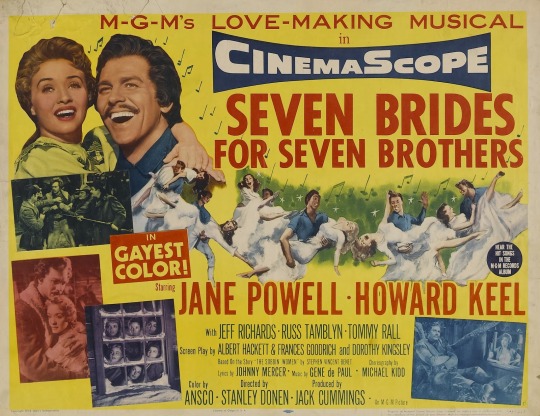

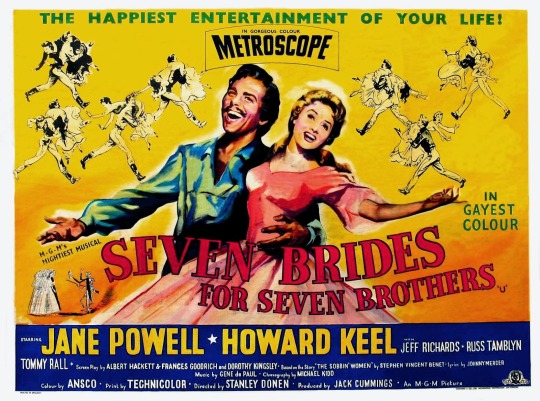

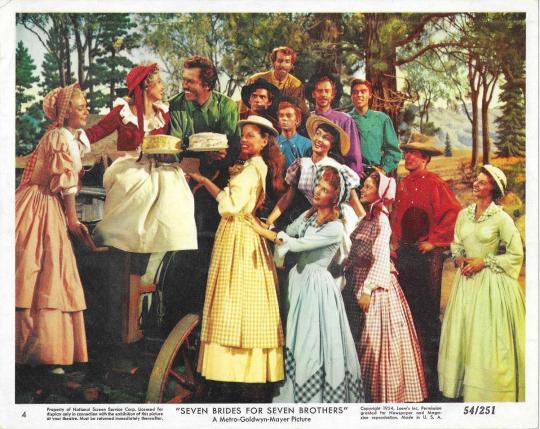

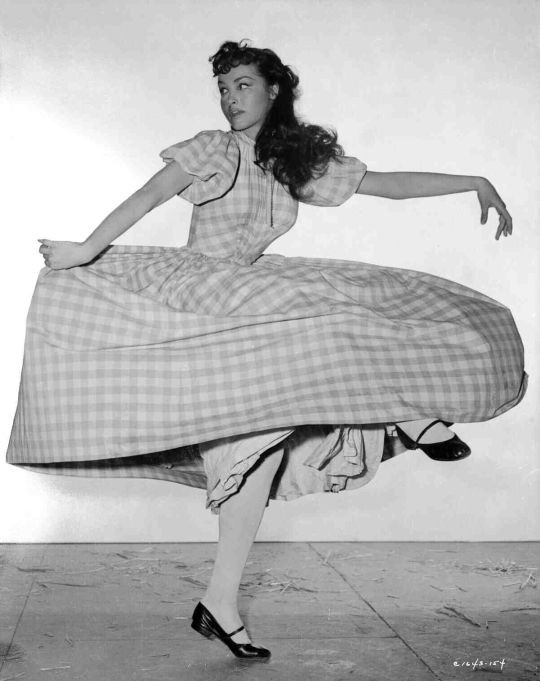


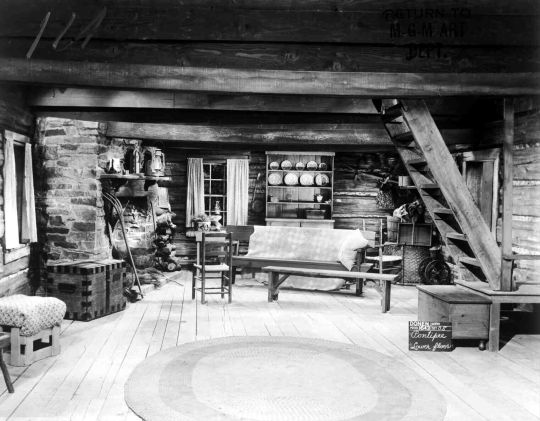
Seven Brides for Seven Brothers (1954) Stanley Donen
January 11th 2023
#seven brides for seven brothers#1954#stanley donen#jane powell#howard keel#russ tamblyn#jeff richards#tommy rall#julie newmar#ruta lee#matt mattox#nancy kilgas#virginia gibson#jacques d'amboise#norma doggett#marc platt#betty carr#the sobbin' women#a bride for seven brothers
43 notes
·
View notes
Photo

Jane Powell, Virginia Gibson, Norma Doggett, Ruta Lee, Betty Carr, Nancy Kilgas, and Julie Newmar (Seven Brides for Seven Brothers, 1954)
27 notes
·
View notes
Photo

The Brides
#art#painting#drawing#gouache#illustration#Seven Brides For Seven Brothers#fanart#musical#movies#classic movies#MGM#Julie Newmar#Ruta Lee#Norma Doggett#Virginia Gibson#Betty Carr#Nancy Kilgas#Stanley Donen#movie scenes#movie illustration#june bride#girls
3 notes
·
View notes
Photo
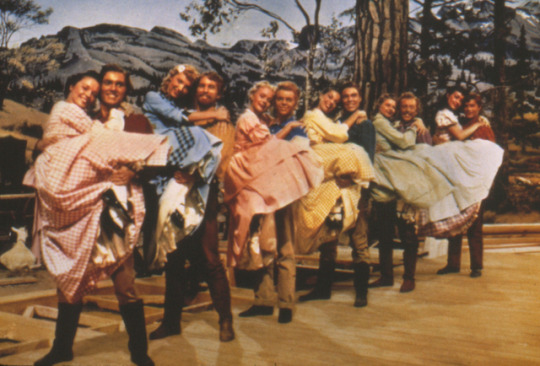
Seven Brides for Seven Brothers (1954)
In the early 1950s, Metro-Goldwyn-Mayer (MGM) had reached the peak of the studio’s powers, becoming the de facto home of the American movie musical. Its recent releases read like an honor roll: In the Good Old Summertime (1949), On the Town (1949), Annie Get Your Gun (1950), An American in Paris (1951), and Singin’ in the Rain (1952). For 1954, MGM needed to juggle two future additions to that list: Brigadoon and Seven Brides for Seven Brothers. The former starred Gene Kelly and Cyd Charisse, was directed by Vincente Minnelli (1944′s Meet Me in St. Louis, An American in Paris), and produced by the famed Arthur Freed unit. The Freed unit produced all of MGM’s A-list musicals, so the studio relegated Seven Brides for Seven Brothers as a “B” picture – cutting its production budget, slashing advertising expenditures. Stanley Donen’s (Singin’ in the Rain, 1955′s It’s Always Fair Weather) movie came dangerously close to being permanently shelved by MGM, but production did commence. In the end, Seven Brides for Seven Brothers outperformed Brigadoon in almost all metrics. And despite its very politically incorrect premise, it has held up better than Brigadoon as well as most musical films from that decade.
It is 1850 in Oregon Territory. Adam Pontipee (Howard Keel) has come down from the mountains – chest forward, masculinity erect for all the villagers to see – to announce he is here to find a bride. After eavesdropping on Milly (Jane Powell) and noting her sassiness and dedication to finishing her chores, he proposes, and she accepts without much question or resistance. Believing she is going home with Adam and only Adam, she is surprised that he also lives with six younger brothers – Benjamin (Jeff Richards), Caleb (Matt Mattox), Daniel (Marc Platt), Ephraim (Jacques d’Ambroise), Frank (Tommy Rall), and Gideon (Russ Tamblyn) – all of whom are ill-mannered slobs, are conveniently colored-coded by the costume design, and most of the six younger Pontipee brother actors are dancers (explained below). Furious at Adam, Milly demands an explanation. He responds that living in the backwoods requires men and women depending on each other to thrive. In time, Milly decides to teach the seven brothers proper etiquette and how to clean up after themselves.
I would be remiss without mentioning the six other women who become the brides (in alphabetical order with who they are hitched with, from Benjamin to Gideon): Dorcas (Julie Newmar), Ruth (Ruta Kilmonis), Martha (Norma Doggett), Liza (Virginia Gibson), Sarah (Betty Carr), and Alice (Nancy Kilgas).
Seven Brides for Seven Brothers is based on “The Sobbin’ Women” by Stephen Vincent Benét – a parody of the Roman mythological tale of the Rape of the Sabine Women. Wait! One quick explanation, please! Regarding the Rape of the Sabine Women, the word “rape” in the classical context refers to the Latin word “raptio”, which means abduction rather than the contemporary definition of rape. But this means the six other brides will be abducted by the Pontipee siblings – setting up the film’s frantic, comedic finale. A piece of modern feminism Seven Brides is not. Yet viewers need to consider that the seven men in the film have lived their lives in the Oregonian forests, with only Adam having infrequent contact with women and society at the most. The six younger Pontipee brothers might never have met women in a social context; their only understanding of women is through the Greek/Roman myths that Milly has read to them (considering the Rape of Sabine Women and Zeus/Jupiter’s behavior, you are right to be a bit horrified).
The Pontipees know nothing of physical boundaries, being respectful of women, and believe that they – perhaps not necessarily as men, but as individuals – should have what they want. Do you really expect them to not behave like lechers? Through the musical score, Seven Brides positions itself as a satire (and, especially in a scene where the younger Pontipees are trying not to knock other men’s lights out, often a hilarious one), never endorsing the behaviors of the Pontipee brothers. This tale of frontier courtship integrates Stockholm Syndrome (a psychological condition in which a hostage develops sympathetic feelings for their captor; also a narrative trope that has been abused by numerous artistic mediums). This is the point where the film’s screenplay by Albert Hackett (The Thin Man series), Frances Goodrich (Hackett’s spouse and co-writer), and Dorothy Kingsley (numerous Esther Williams movies including 1953′s Dangerous When Wet). As entertaining as Seven Brides is from its opening minutes, the women just seem too forgiving of the Pontipee brothers. Milly, in her active and open resistance to all that Adam is teaching his younger siblings, turns a one-sided argument into a battle of the sexes – making this a far more watchable film than it might otherwise have been.
For the musical team of supervisor Saul Chaplin (1961′s West Side Story), score composer Adolph Deutsch (1960′s The Apartment), song composer Gene de Paul, lyricist Johnny Mercer (maybe the best English-language lyricist from the 1930s-50s), and orchestrators Leo Arnaud (a longtime MGM contractee best known for “Bugler’s Dream”, a theme for American television’s presentation of the Olympics) and Alexander Courage (also a long-serving MGM contractee, but best known for his theme to Star Trek: The Original Series), Seven Brides for Seven Brothers’ musical score is spectacular from the very first song.
That first song? “Bless Your Beautiful Hide”, sung by Howard Keel in the opening minutes. The catchiest song in the film, it also serves as burning a hole through any expectations of clumsy or overlong exposition that can ruin a musical. In two-and-a-half minutes of Keel’s accented, blustering, unusually expressive bass-baritone, “Bless Your Beautiful Hide” has successfully introduced Adam Pontipee – that he is searching for a woman to sling over his shoulder, that she be at least conventionally pretty and not fat, can do work around the house, and someone who is “SASSY as can be!” One could not ask for a better introductory song than this. The song, “When You’re In Love” is a demonstration of Milly’s more refined nature against the rugged Adam. It is the song’s reprise – sung by Adam? – that poses problems. Keel also objected to the reprise’s placement in the film, saying that Adam did not understand what love is the moment he reprises the song (one could interpret it as Adam parroting Milly’s song, not fully understanding the lyrics, but I am not of that camp). Other highlights include Jane Powell singing “Goin’ Courtin’” a few scenes before Adam counters with “Sobbin’ Women” – recounting the story of the Rape of the Sabine Women, and setting the film’s resolution in motion. Seven Brides might not have the most memorable score, but it’s musically fascinating and I can’t label any of its de Paul and Mercer songs – okay, maybe “Wonderful, Wonderful Day” – as a dud.
But we haven’t gotten to the film’s ultimate musical accomplishment yet. Enter the barn dance sequence – an inspired composition by Adolph Deutsch and choreographer Michael Kidd (1953′s The Band Wagon, It’s Always Fair Weather). Alongside the excellent orchestration by Arnaud and Courage, the cue that accompanies this scene is just as fun to listen to within the film as well as when removed from it. Based heavily on “Bless Your Beautiful Hide”, the melody is passed back between strings and woodwinds with infectious zest. Infectious Western-styled themes; string-crossing; finger-numbing runs from the string section set the pace; and, when timed to the athletic, rather than balletic, choreography (the actors who played the six younger Pontipee brothers, the women, and the other suitors are all magnificent dancers), epitomizes the peak of the 1950s MGM musical. Because of the technical footwork, Donen sought to cast six dancers as the younger Pontipee brothers. Three weeks of rehearsal were needed just to record these several minutes of breathtaking movement.
youtube
Why resort to fisticuffs when things can be settled with a dance-off? Instrumentalists, dancers, and those who just love a good musical number will be left in awe here. For those who wanted to see a cartoonish brawl ensue, don’t feel deflated. This film will fulfill your wishes a few minutes after this, too!
Because of the film’s lack of support from MGM executives, the original plans to shoot on-location in Oregon fell through. The screenplay calls for the depiction of all four seasons, which would require a year-round shoot that MGM did not want to cough up for a “B” picture. Thus, Seven Brides for Seven Brothers would be shot almost entirely on the MGM backlot in a soundstage – which allows for some glaringly artificial painted backdrops and foliage that the viewer needs to overlook to enjoy such an electric musical. With production design as clunky as the Yellow Brick Road backdrops in The Wizard of Oz (1939), Seven Brides for Seven Brothers feels like it could have been made decades earlier. But don’t think Seven Brides is stuck in a previous decade. The film was shot on CinemaScope (a widescreen screen aspect format, though not represented in the video provided for the barn raising sequence, that had been introduced the previous year) as well as the then-industry standard 4:3 format – not all theaters had the technology to present CinemaScope or other widescreen formats yet. As a result, Seven Brides for Seven Brothers was shot in and exists in two different formats: a CinemaScope and a 4:3 version. This review was based on the CinemaScope version shown on Turner Classic Movies (TCM), and it is also the print I recommend you watch.
This is a musical movie I had been holding off on for years, for insubstantial reasons. In the end, Seven Brides for Seven Brothers – because of its depiction of men asserting their own gendered primacy – may not appeal to all audiences, and I will not quarrel with anyone who has given Donen’s film a mindful look. The film is hampered by the nature of its narrative and external, business-side limitations. Those aspects should not define it. Seven Brides for Seven Brothers’ gorgeous musical score culminates in a stunning dance scene and contains an unexpectedly thoughtful look on how a single person can inspire change in another (not exclusively in terms of “fixing” them), making this a splendid addition to the best musical lineup produced by any Hollywood studio.
My rating: 8.5/10
^ Based on my personal imdb rating. Half-points are always rounded down. My interpretation of that ratings system can be found here.
#Seven Brides for Seven Brothers#Stanley Donen#Howard Keel#Jane Powell#Jeff Richards#Julie Newmar#Matt Mattox#Ruta Kilmonis#Marc Platt#Norma Doggett#Jacques d'Amboise#Virginia Gibson#Tommy Rall#Betty Carr#Russ Tamblyn#Nancy Kilgas#Gene de Paul#Johnny Mercer#TCM#My Movie Odyssey
6 notes
·
View notes
Text
THE BOB HOPE CHEVY SHOW
October 21, 1956
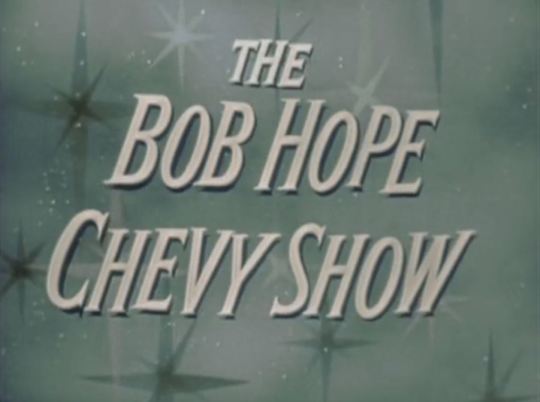
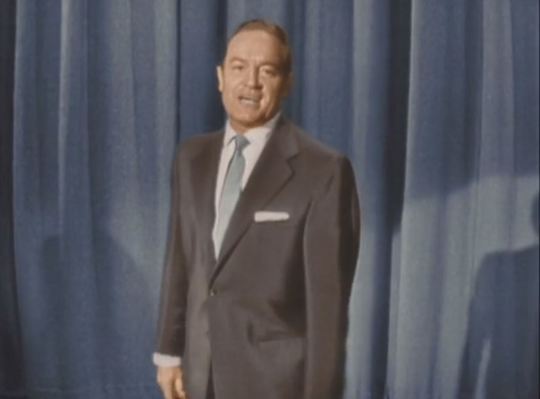
Bob Hope (Himself / Ricky Ricardo) was born Lesley Townes Hope in England in 1903. During his extensive career in virtually all forms of media he received five honorary Academy Awards. In 1945 Desi Arnaz was the orchestra leader on Bob Hope’s radio show. Ball and Hope did four films together. He appeared as himself on the season 6 opener of “I Love Lucy.” He did a brief cameo in a 1964 episode of “The Lucy Show.” When Lucille Ball moved to NBC in 1980, Hope appeared on her welcome special. He died in 2003 at age 100.
Lucille Ball (Lucy Ricardo) was born on August 6, 1911 in Jamestown, New York. She began her screen career in 1933 and was known in Hollywood as ‘Queen of the B’s’ due to her many appearances in ‘B’ movies. With Richard Denning, she starred in a radio program titled “My Favorite Husband” which eventually led to the creation of “I Love Lucy,” a television situation comedy in which she co-starred with her real-life husband, Latin bandleader Desi Arnaz. The program was phenomenally successful, allowing the couple to purchase what was once RKO Studios, re-naming it Desilu. When the show ended in 1960 (in an hour-long format known as “The Lucy-Desi Comedy Hour”) so did Lucy and Desi’s marriage. In 1962, hoping to keep Desilu financially solvent, Lucy returned to the sitcom format with “The Lucy Show,” which lasted six seasons. She followed that with a similar sitcom “Here’s Lucy” co-starring with her real-life children, Lucie and Desi Jr., as well as Gale Gordon, who had joined the cast of “The Lucy Show” during season two. Before her death in 1989, Lucy made one more attempt at a sitcom with “Life With Lucy,” also with Gordon, which was not a success and was canceled after just 13 episodes.
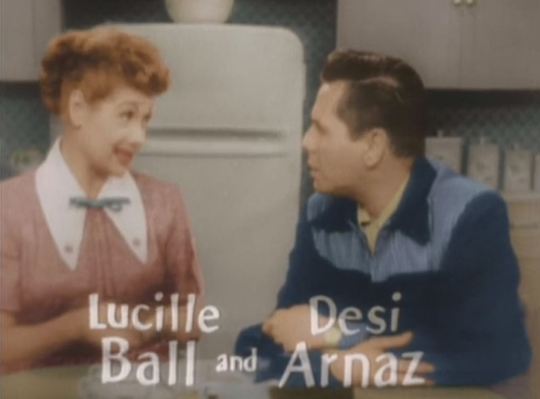
Desi Arnaz (Fred Mertz) was born in Cuba in 1917 and immigrated to America as a youngster. He was a musician who married Lucille Ball in 1940 after meeting her on the set of 1939’s Too Many Girls, which he had done on stage in New York. In order to keep him ‘off the road’ Ball convinced producers to cast him as her husband in a new television project based on her radio show “My Favorite Husband.” The network was convinced. In 1951, Arnaz and Ball began playing Lucy and Ricky Ricardo, roles they would be identified with for the rest of their lives. The couple had two children together, Lucie and Desi Jr. In 1960, Ball and Arnaz divorced. Desi became a producer, responsible for such hits as “The Mothers-in-Law” (1967-69). He re-married in 1963. Desi Aranz died in 1986, just a few years before Ball.

Vivian Vance (Ethel Mertz) was born Vivian Roberta Jones in Cherryvale, Kansas in 1909, although her family quickly moved to Albuquerque, New Mexico where she was raised. She had extensive theatre experience, co-starring on Broadway with Ethel Merman in Anything Goes. She was acting in a play in Southern California when she was spotted by Desi Arnaz and hired to play Ethel Mertz, Lucy Ricardo’s neighbor and best friend. The pairing is credited with much of the success of “I Love Lucy.” Vance was convinced to join the cast of “The Lucy Show” in 1962, but stayed with the series only through season three, making occasional guest appearances afterwards. She made a total of six appearance on “Here’s Lucy.” She also joined Lucy for a TV special “Lucy Calls the President” in 1977. Vance died two years later.
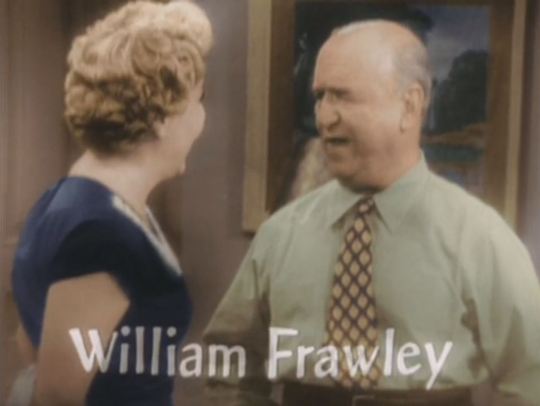
William Frawley (Captain Blystone) was already a Hollywood veteran when he was hired by Desi Arnaz to play Fred Mertz on “I Love Lucy.” After the series concluded he joined the cast of “My Three Sons” playing Bub Casey. He did an episode of “The Lucy Show” in October 1965 which was his final TV appearance before his death in March 1966.
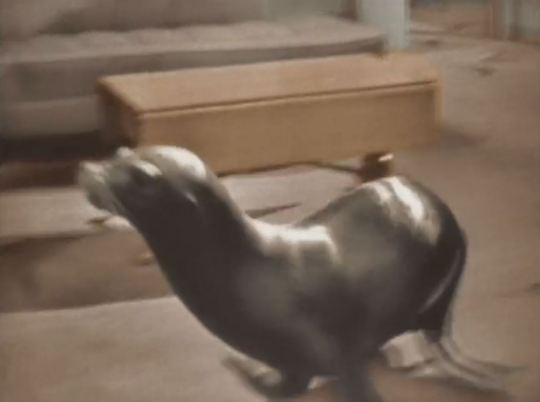
Tommy (Trained Seal) Others guests on the show that evening were James Cagney, Diana Dors, New York Yankee Don “No Hit” Larsen, and Les Brown and his Band of Renown.
The Hollywood DebStars (up and coming young women in the entertainment business nominated by the make-up industry) include:
Nicola Michaels aka Niki Dantine (from MGM)
Elaine Aikens aka Elaine Aiken (from Paramount)
Dani Crayne (from Warner Brothers)
Anna Navarro (from NBC)
Nancy Kilgas (from CBS)
Roxanne Arlen (from Pine Talent Productions)
Stephanie Griffin (from DelBar Productions)
Carol Nugent (from American National Studios)
Autumn Russell (from Al Wallace)
Veneita Stevenson (from RKO)
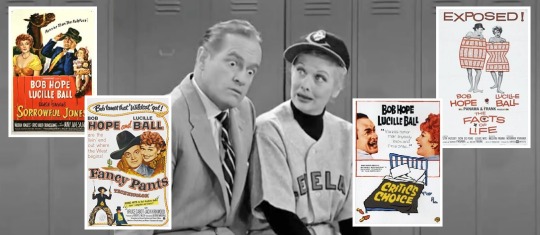
This cross-over episode of “The Bob Hope Show” aired on NBC (Hope's network of choice) two weeks after his guest-star appearance as himself on the season six opener of “I Love Lucy.”
Because the show is sponsored by Chevrolet, the opening theme is their jingle “See the U.S.A. In a Chevrolet” by Leo Corday and Leon Carr. Dinah Shore sang the song after 1952, and it became something of a signature song for her. Later the song was also sung by Pat Boone on his “Pat Boone-Chevy Showroom” (1957-60) on ABC. Hope's signature tune “Thanks for the Memory” by Ralph Rainger is saved for the closing credits, with special lyrics about the 1957 Chevies.

In Hope's opening monologue, he promises a look at the new 1957 Chevrolet cars. He then alludes to the new TV season. Hope wonders who is running the country with Walter Winchell on TV and IKE out campaigning. Winchell's new NBC variety series was titled “The Walter Winchell Show” and it premiered three days before this “The Bob Hope Chevy Show.” It lasted just one season. A month after Hope mentioned IKE campaigning, Eisenhower handily won election to a second term as US President.
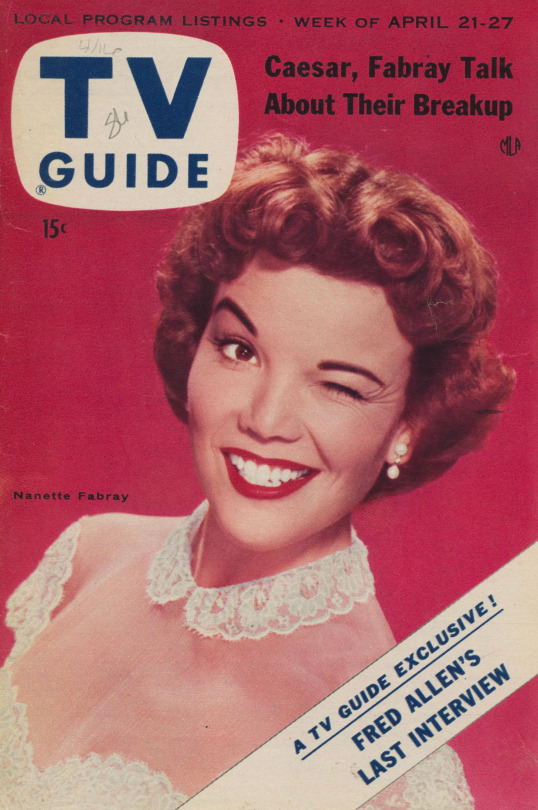
Hope says that Sid Caesar's back – with a new wife. Hope is referring to the third season of NBC's “Caesar's Hour.” Nanette Fabray left the show after a misunderstanding when her business manager, unbeknownst to her, made unreasonable demands during contract renewal negotiations. Fabray and Caesar did not reconcile until years later. Fabray appeared with Lucille Ball in the her 1974 special “Happy Anniversary and Goodbye.”
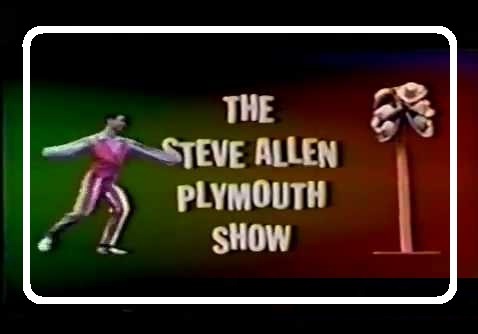
Hope says that Steve Allen is back and busy as ever. Allen's new show on NBC was titled “The Steve Allen Plymouth Show” (another show sponsored by a car manufacturer) and would run five seasons. Steve Allen interviewed Lucy Whittaker (Lucille Ball) in 1977′s “Lucy Calls the President.”
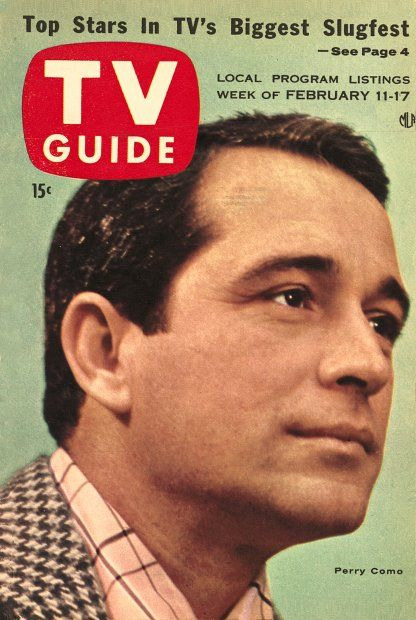
Hope also reports that Perry Como is back. Hope is referring to Como's hosting of “The Kraft Music Hall.” Como appeared on the premiere of the aforementioned “Walter Winchell Show” to promote the “Kraft Music Hall.”
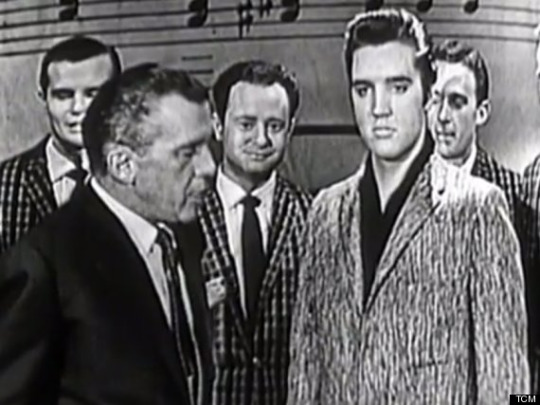
Trying to make a joke about “The Ed Sullivan Show” (which he says “owns Sunday nights), Hope mistakenly says “Elvin Presley” instead of “Elvis Presley.”
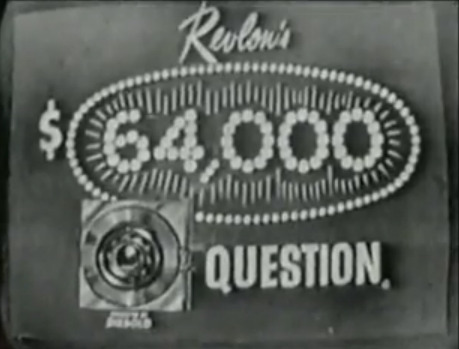
Hope does a joke about Winston Churchill's son being on “The $64,000 Question.” On September 18, 1956, a month before this Bob Hope Show first aired, Rudolph Churchill was a guest contestant on the American quiz show hosted by Lucille Ball's friend Hal March. Churchill and the other contestants all got the answers right that evening and it was discovered that they were already given the answers. This began what is know as the quiz show scandals in Hollywood.
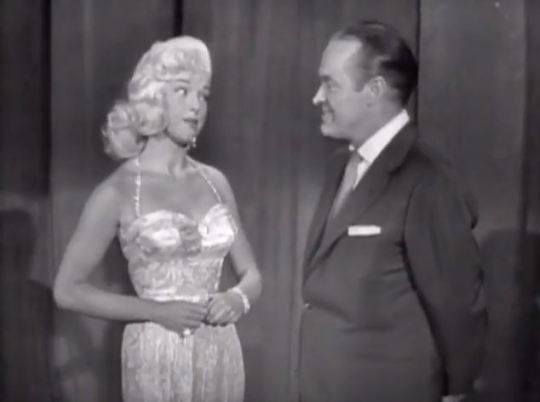
English-born Diana Dors does a sketch where she plays Hope's wife in a traditional English cottage. Dors and Hope then do a companion sketch about a married couple in modern day America where the house practically cleans itself. They even have a baby (several) thanks to automation.
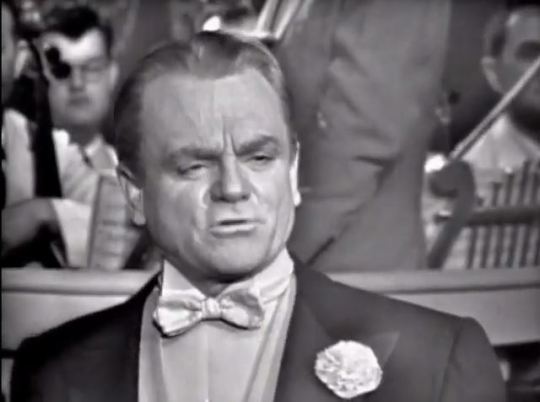
Hope and Cagney sing and dance to “Mary's a Grand Old Name” by George M. Cohan. Cagney won an Oscar for playing George M. Cohan in the 1942 film Yankee Doodle Dandy, which also featured the song. It was also in the film The Seven Little Foys (1955), which is mentioned by Hope. Cagney says he is doing a new film about Lon Chaney called Man of a Thousand Faces. It was released in 1957. Hope also makes a joke about Burt Lancaster's 1956 film Trapeze.

During Hope and Cagney’s introductions of the DebStars, background singers perform “A Pretty Girl Is Like A Melody,” “You Oughta Be in Pictures” and “You Are Too Lovely.”
After ogling the DebStars, Cagney does an imitation of Ernest Borgnine saying “What're you doin' tonight, Marty?” from the 1955 film Marty. About Cagney, Hope says he's such a tough guy that he thinks Somebody Up There Likes Me is a comedy. The dramatic 1956 film is about the life of boxer Rocky Graziano.
Hope rightfully states that he knew Lucy long before she met Desi and wonders what it would be like if he'd married Lucy. This sets up the premise of the “I Love Lucy” cross-over sketch that follows.
The “I Love Lucy” theme is played at the start of the sketch.
Although the “I Love Lucy” set is used, it is slightly changed to accommodate the action. There are now closet doors at the extreme left and right edge of the set. The set dressing in the hallway is also different.

The sketch was probably recorded in advance, possibly on the “I Love Lucy” stage, to accommodate the cast, including the live seal. This is born out by the fact that during Hope's “curtain call” during the final credits, only William Frawley and Vivian Vance come out to shake Hope's hand, and they are dressed in different clothes than they were wearing moments before. Lucille Ball and Desi Arnaz do not appear as “themselves” out of context of the characters they play in the sketch.
The action opens on the Ricardo's New York City apartment with Lucy leading a live seal from the front door into the living room closet. Ball has some trouble getting the seal through the closet door, despite tempting it with food.
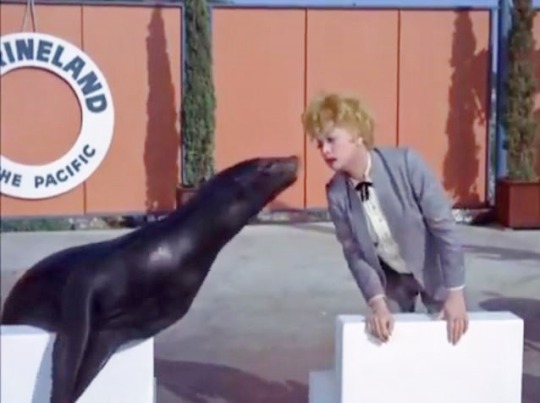
Lucille Ball would work with live seals again in “Lucy at Marineland” (TLS S4;E1).
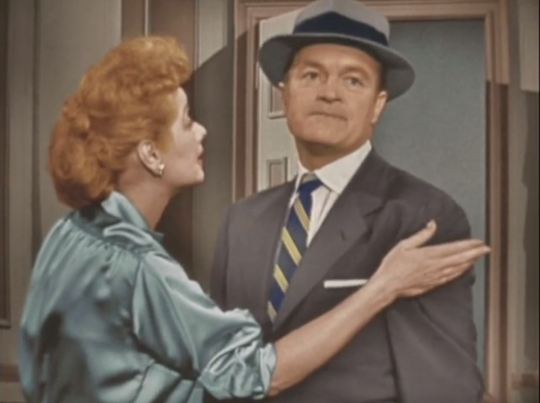
When Ricky (Bob Hope) comes home, Lucy smothers him with kisses, which makes him suspicious that something is up.
Lucy: “What are you talking about? I give you a kiss every day.” Ricky: “I know, but this is October. You just kissed me through Lincoln's Birthday.”
Lincoln's Birthday was formerly a Federal holiday celebrated on February 12. It is now marked only in select states, having been replaced by Presidents’ Day at the Federal level.
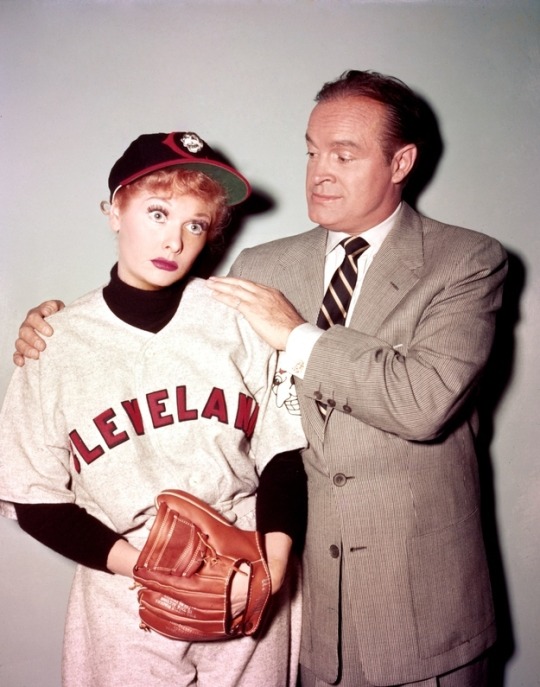
When Ricky tosses his hat into the closet where the seal is hiding, it immediately comes flying back at him, nearly landing back on his head, but missing.
Lucy: “We've got termites!” Ricky: “One of them must pitch for Cleveland.”
Hope was part-owner of the Cleveland Indians, and never missed an opportunity to joke about the team.
Lucy says she was just trying to help by getting the closet fumigated.
Ricky: “You're always helping, like when we went on our honeymoon. You thought we'd be lonesome so you invited your mother along.” Lucy: “I was just trying to help.” Ricky: “Who were you helping? You're father?”
While Lucy Ricardo's mother was an integral part of “I Love Lucy” in its last few seasons, her father was never mentioned. In real-life, Lucille Ball's father died when she was an infant and she was raised by her grandfather. Like most cross-overs, Hope's writers appear not to have been avid watchers of “I Love Lucy.”
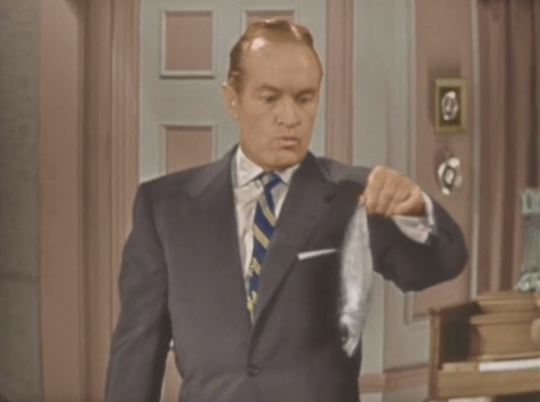
Seeing a plate of whole fish (the seal's food) on the coffee table, Ricky gets suspicious. He calls them “Texas anchovies.” Lucy explains that they are her first dividend from her membership in the Herring of the Month Club.
Ricky says he has an audition in the morning for the 100-piece Havana Symphony Orchestra: 99 bongos and a sweet potato.
When Fred enters (played by Desi Arnaz), Lucy barely recognizes him:
Lucy: “Well Fred, I didn't recognize you. You look like a new man. Took off a little weight, put on a little hair.”
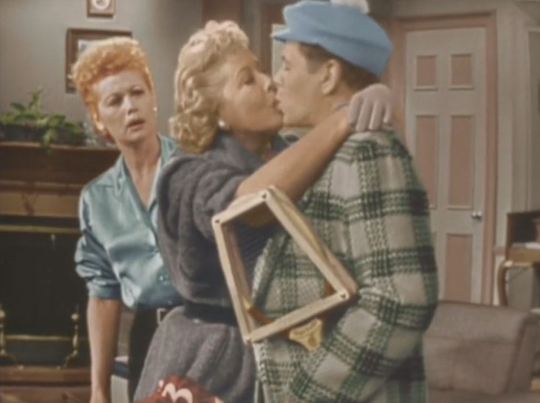
When Ethel smothers Fred (Ricky) in kisses, Lucy (or Lucille Ball) says “All right, break it up. Let's not overdo it.” On “I Love Lucy,” Vivian Vance did not enjoy having to be affectionate with William Frawley. If the script required them to smooch, an air kiss was all Frawley and Vance would do - and that reluctantly.
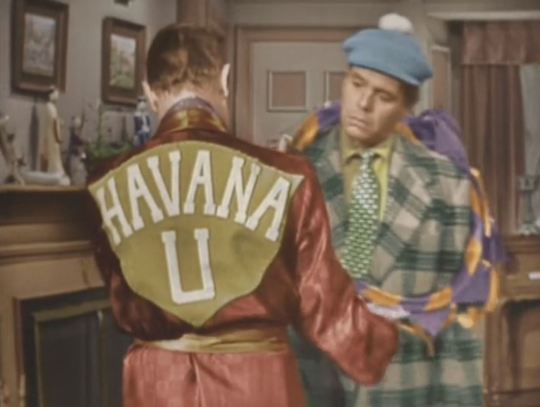
When Ricky (Hope) turns his back to the audience, his bathrobe says “Havana U” on it.

On “I Love Lucy” Ricky Ricardo claimed to have attended the University, and even sang their fight song in one episode.
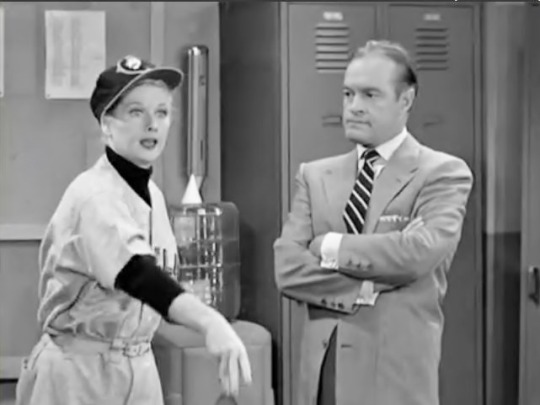
When Ricky can't understand Fred's thick Cuban accent, Bob Hope recycles a punchline he also used on “Lucy Meets Bob Hope” (ILL S6;E1) the week before: “You're trying to tell me something!”
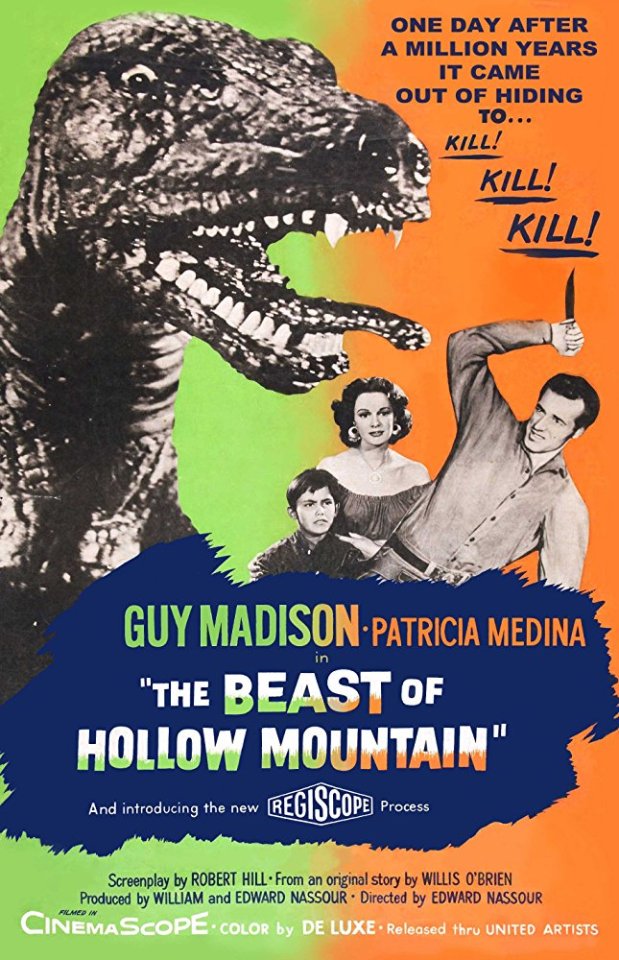
Lucy insists on playing charades. When Ricky complains he needs to go to bed, he asks Lucy “Who do you think I am?” As if a charade clue, she quickly replies “The Beast From Hollow Mountain”! This was the title of a low-budget horror flick about a modern-day dinosaur on the loose. The movie was released in August 1956.
When Lucy announces that Fred and Ethel's apartment is being fumigated (to hide that Captain Blystone is staying there), she says that the girls will sleep in the bedroom and the boys will take the living room. Hope breaks the fourth wall to address the audience:
Hope: “How do you like that? I marry Lucy and wind up with Desi.”
Both Ricky and Fred dive for the sofa at the same time. Hope is still straddling the fourth wall.
Hope (to Desi): “One chorus of 'Babalu' and out you go.”
Then Desi mutters under his breath “I should have never left CBS” which is likely an ad-lib by Arnaz.
When Ricky opens the closet door a huge circus ball rolls out. Lucy claims it is a beach ball for the little girl next door. When Ricky (Hope) tries to lift it, it is heavy, and he remarks “Who's the little girl? Sophie Tucker?”
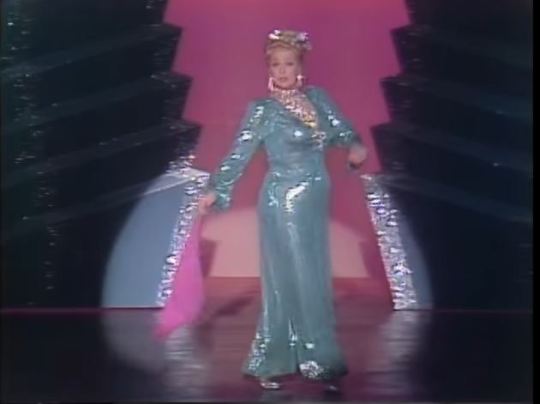
Sophie Tucker was a vaudeville personality of sturdy build. Lucille Ball would play Tucker on “Bob Hope's All-Star Comedy Salute to Vaudeville” in 1977.
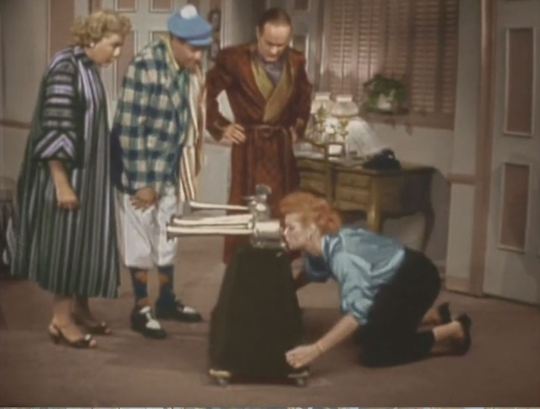
In another closet, Ricky finds what Lucy calls a ‘gramasousaxylophonovitch’, a series of horns arranged like a xylophone.
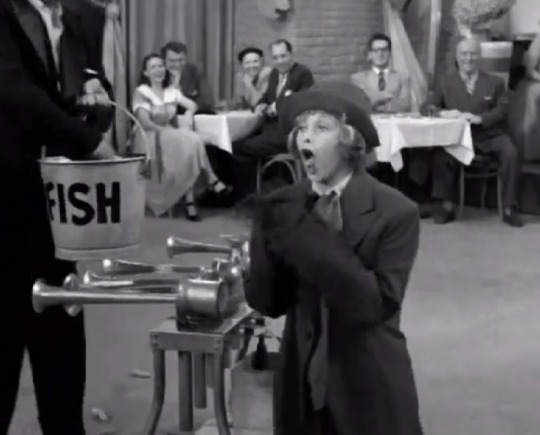
Five years earlier, on “The Audition” (ILL S1;E6), Lucy Ricardo pretended to be a trained seal and played "How Dry Am I" on the (what she called then) the ‘saxavibratronophonovitch’, but is virtually the same instrument. This was also part of the act Lucille Ball and Desi Arnaz toured live across the country to convince CBS and sponsors that their pairing would work on television.
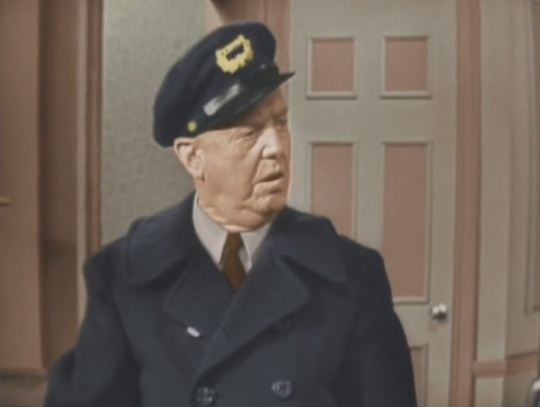
Lucy's performance wakes Captain Blystone (William Frawley) upstairs, who comes to claim his seal, who he calls Tommy. Lucy introduces the seal as her music teacher!
#The Bob Hope Show#The Bob Hope Chevy Show#Chevrolet#1956#NBC#I Love Lucy#Lucille Ball#Desi Arnaz#Vivian Vance#trained seal#Jimmy Cagney#Diana Dors#DebStars#Don Larsen#New York Yankees#Cleveland Indians#Marty#Somebody Up There Likes Me#$64000 Question#The Seven Little Foys#Mary's A Grand Old Name#Yankee Doodle Dandy#Trapeze#Man of a Thousand Faces#See the USA in a Chevrolet#Thanks for the Memory#The Walter Winchell Show#Caesar's Hour#Nanette Fabray#Elvis Presley
6 notes
·
View notes
Photo

On the film set of '7 Brides'
60 notes
·
View notes
Photo

Nancy Kilgas, Julie Newmar, Jane Powell, Ruta Lee, Betty Carr, Virginia Gibson, and Norma Doggett (Seven Brides for Seven Brothers, 1954)
23 notes
·
View notes
Photo
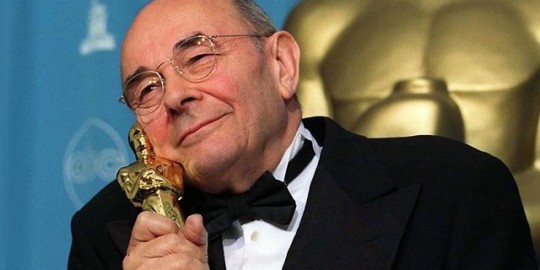

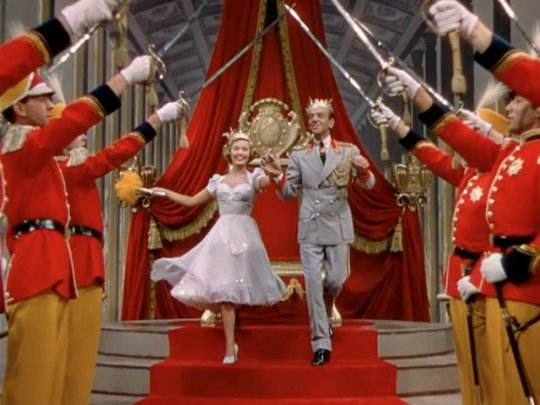
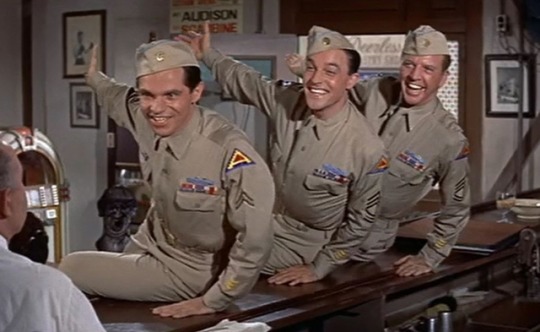
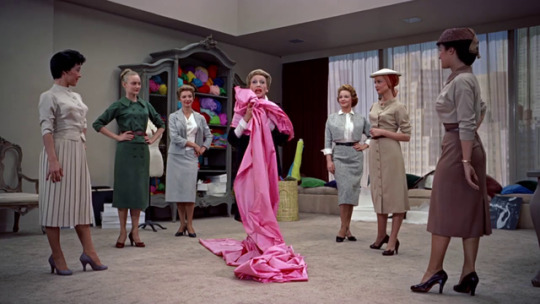
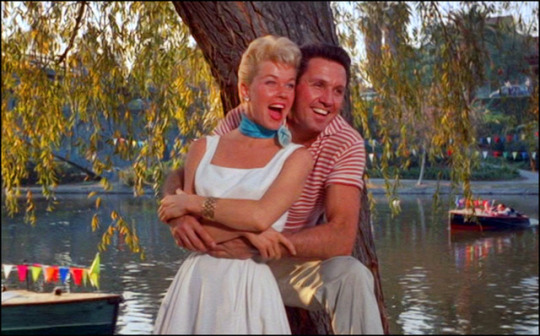

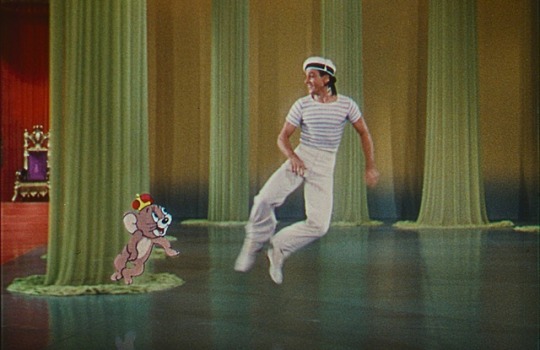
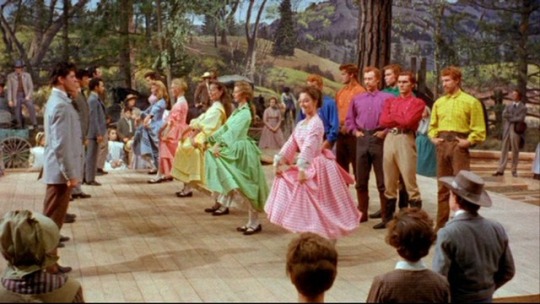
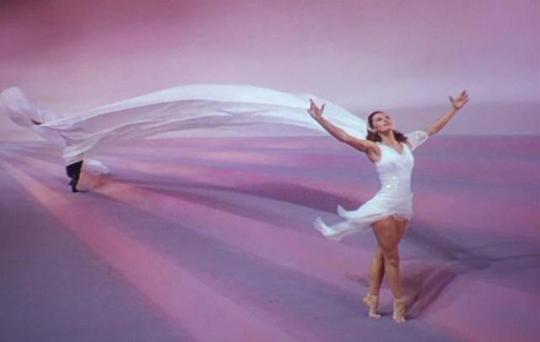
If we bring a little joy into your humdrum lives, it makes us feel as though our hard work ain't been in vain for nothin'. Bless you all.
Stanley Donen (born April 13, 1924) was one of the best directors in cinema, but is almost always excluded from such lists. That might be because of the genre he found the most success in. Donen -- who passed away from heart failure this Saturday -- was born and raised in Columbia, South Carolina and was led to believe he would help out with his father’s dress shop. But after seeing Fred Astaire and Ginger Rogers dance in Flying Down to Rio (1933), the direction of his career was destined for Hollywood. Donen took dance lessons and excelled -- taking him to Broadway’s theaters in the 1940s as a choreographer.
He came to Hollywood with his friend, Gene Kelly, and became contracted to Metro-Goldwyn-Mayer (MGM), serving as choreographer for films like Cover Girl (1944) and Anchors Aweigh (1945; the scene where Gene Kelly dances with Jerry Mouse was Donen’s idea). Donen’s dance direction led him to direct his first film, On the Town -- the beginning of a directorial career (at times co-director with Kelly; their professional relationship would become complicated over the years) that would define the Hollywood mid-century musical. Though Donen did not exclusively direct musicals, his strong association with the genre -- its colors, heavy stylization, and Hollywood Studio System-exuberance -- tends to see many devalue many of his musicals not entitled Singin’ in the Rain. Donen was awarded the Academy Honorary Award for a lifetime of achievement in 1998.
Nine of the films he worked on are pictured above, and are listed below (left-right, descending):
On the Town (1949) -- co-directed with Gene Kelly; starring Kelly, Frank Sinatra, Betty Garrett, Ann Miller, Jules Munshin, and Vera-Ellen
Royal Wedding (1951) -- starring Fred Astaire, Jane Powell, Sarah Churchill, Peter Lawford, and Keenan Wynn
It’s Always Fair Weather (1955) -- co-directed with Gene Kelly; starring Kelly, Dan Dailey, Cyd Charisse, Dolores Gray, Michael Kidd, and David Burns
Funny Face (1957) -- starring Audrey Hepburn, Fred Astaire, Key Thompson, Michel Auclair, and Robert Flemyng
The Pajama Game (1957) -- co-directed with George Abbott; starring Doris Day, John Raitt, Carol Haney, Eddie Foy Jr., and Barbara Nichols
Charade (1963) -- starring Cary Grant, Audrey Hepburn, Walter Matthau, James Coburn, and George Kennedy
Anchors Aweigh (1945) -- directed by George Sidney; starring Frank Sinatra, Kathryn Grayson, and Gene Kelly; featuring animation supervised by William Hanna and Joseph Barbera
Seven Brides for Seven Brothers (1954) -- starring Howard Keel, Jane Powell, Jeff Richards, Matt Mattow, Marc Platt, Jacques d’Amboise, Tommy Rall, Russ Tamblyn, Julie Newmar, Ruta Lee, Norma Doggett, Virginia Gibson, Betty Carr, and Nancy Kilgas
Singin’ in the Rain (1952) -- co-directed with Gene Kelly; starring Kelly, Donald O’Connor, Debbie Reynolds, Jean Hagen, Millard Mitchell, Cyd Charisse, Douglas Fowley, and Rita Moreno
#Stanley Donen#Singin' in the Rain#Seven Brides for Seven Brothers#Charade#Funny Face#On the Town#Royal Wedding#It's Always Fair Weather#The Pajama Game#Anchors Aweigh#Tom and Jerry#Hanna Barbera#in memoriam#31 Days of Oscar
56 notes
·
View notes